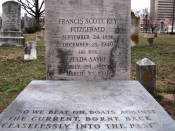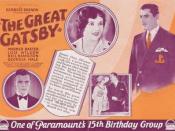Gatsby's Pursuit of Dream
The American dream has always offered a belief the possibility of a better life. Its illusion is the conviction that material wealth alone can bring that dream to fulfillment. Jay Gatsby, the central character of F. Scott Fitzgerald's The Great Gatsby, symbolizes the American dream during the Roaring Twenties. The novel portrays Gatsby's attempts of obtaining love through the pursuit of wealth which, in the end, blinds him from the harsh truth of his lover's betrayal.
To begin with, Gatsby strives to win back his former lover Daisy by accumulating mass wealth and earning a respectable social status. Nick reveals to the audience the past between Daisy and Gatsby. Daisy left Gatsby after World War I because he had neither money nor social standing, therefore incapable of supporting a family. The breakup motivates Gatsby to reinvent himself as a sophisticated millionaire in order to gain approval from Daisy.
In this aspect, Daisy serves as the ultimate goal of Gatsby's life-long quest. At the beginning of the novel, Nick, the narrator, notices Gatsby as he "stretched out his arms toward the dark water in a curious way" (Fitzgerald 25). Gatsby's reaching toward the green light from Daisy's side of the town symbolizes his futile attempt in winning back Daisy. Furthermore, Nick's comment of Gatsby as a man who "sprang from his Platonic conception of himself" (Fitzgerald 104) confirms Gatsby's determination in emerging from society as a cultured aristocrat. He reveals his desire to remake himself by changing his name from James Gatz to Jay Gatsby.
Furthermore, Gatsby's blinding love for Daisy and Daisy's own materialistic personality marks the doom of their relationship in the end. Gatsby throws extravagant parties "stocked with gins and liquors" (Fitzgerald 44). Again, Gatsby's excessive spending serves as the means with...


